Message from Quarantine Island nr 2, Mels Dees
Terschelling, April 5, 2020
Islands have always played an important role in my life and work. I was raised on an island in Zealand – Walcheren – and I spent years and years roaming its beaches. Later, I visited and lived in places like Taquile (Titicaca), Becquia and the Grenadines. Marielle and I explored even more remote islands: Iceland, Tasmania, and Naoshima, among others. And last year we spent a rather cold and damp, but entirely satisfying summer on the Faroër islands. All the time, islands to us were a place to concentrate on our work and forget about the distractions of everyday life.
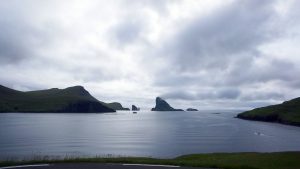
Faroe Islands (181 patients)
But things are changing. Living and working on Crete in the early 1980’s, I had to take the ferry to Athens to send texts by fax to my publisher- there wasn’t a serviceable fax machine on the island. Now, there’s hardly any place in this world without Wifi or Internet connection. It’s a simple market mechanism: if you have a hostel or a holiday cottage without Wifi, the guests just won’t come. The good thing about being on our Quarantine Island is, that while we are more or less bombarded with overviews of an unfolding global drama, we have the time and peace & quiet to concentrate on smaller and possibly more important things.
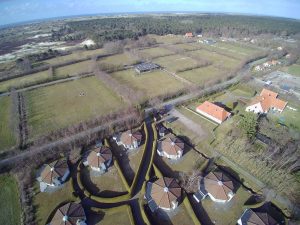
A grand view of our present island cottage – mark the earth’s curve…
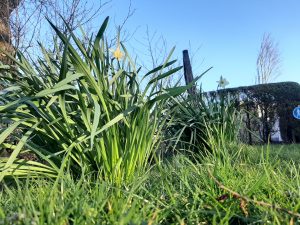
And the green stuff popping up around our house
So much for island philosophy. Although… I haven’t mentioned yet that we are simultaneously working on another (island) project. At the end of the year, if the all-powerful Crown allows, Marielle and I will have an exhibition with Katy Woodroffe from Tasmania. We revisited the island almost two years ago, and I was again overwhelmed by the homely weirdness of the place. The show will be in the Dutch town of Schijndel, at the end of this year.
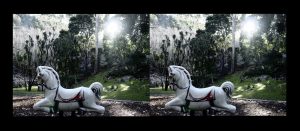
From a series of stereo photographs made in Tasmania (2006)
One of the most disturbing stories about Tasmania is this: about 10.000 years ago, the land bridge between Tasmania and Australia was washed away by the rising sea level. The aboriginals living in Tasmania were isolated from their mainland family and, over the course of the centuries, they lost their culture.
They almost completely forgot how to make clothes, fire or tools and lived on the island’s beaches, naked and subsisting mostly on shellfish. The story is remarkably similar to that of the Haush Indigenas in Tierra del Fuego, and like them they were an easy prey for the white men, when they came.
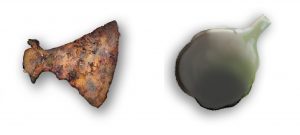
Possible tools, digital watercolour, 2020
So for the coming exhibition I am developing ideas about disappearing and emerging tools, making watercolour notes on the computer to prepare for a ceramic session in Guldagergaard, Denmark. Again, if the Corona gods allow, we’ll be working there this autumn and I want to make series of crumbling ceramic works, somewhere in between tools, protheses, and natural objects. The gallery’s floor as a beach. And beachcombing along Terschelling’s coastline helps a lot, of course.
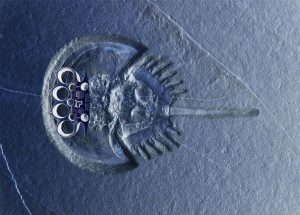
Terschelling, latest update: 1 Corona patient
You Might Also Like:
Van Luong (1)
 Kjell Zillen (4)
Kjell Zillen (4) Mels Dees (9)
Mels Dees (9) Gao Yu (4)
Gao Yu (4)Katya Lebedev (1)
Juan Dies (1)
 Anastasia Prahova (2)
Anastasia Prahova (2)Nena Nastasiya (7)
Taarn Scott (6)
 Cynthia Fusillo (20)
Cynthia Fusillo (20)Roberta Orlando (8)
 Nanda Raemansky (25)
Nanda Raemansky (25) Eliane Velozo (22)
Eliane Velozo (22)Leyya Mona Tawil (1)
Julia Dubovyk (2)
Jianglong (2)
 Iara Abreu (23)
Iara Abreu (23) Agathe Simon (1)
Agathe Simon (1)Rosetta Allan (1)
Elizaveta Ostapenko (5)
 Valentin Boiangiu (2)
Valentin Boiangiu (2) Wesley John Fourie (9)
Wesley John Fourie (9) Renato Roque (3)
Renato Roque (3)Rosa Gauditano (5)
Neerajj Mittra (34)
Ciana Fitzgerald (5)
Boris Moz (3)
 Katerina Muravuova (5)
Katerina Muravuova (5)Kyla Bernberg (1)
 Muyuan He (1)
Muyuan He (1)Liza Odinokikh (2)
 Amalia Gil-Merino (2)
Amalia Gil-Merino (2)Paulo Carvalho Ferreira (6)
 Anastasiia Komissarova (2)
Anastasiia Komissarova (2) Yumiko Ono (1)
Yumiko Ono (1) Stefania Smolkina (1)
Stefania Smolkina (1)Lena Adasheva (1)
 Zahar Al-Dabbagh (1)
Zahar Al-Dabbagh (1) Emily Orzech (6)
Emily Orzech (6) Fernanda Olivares (5)
Fernanda Olivares (5) Noor van der Brugge (3)
Noor van der Brugge (3) Ira Papadopoulou (2)
Ira Papadopoulou (2) Tom Chambers (8)
Tom Chambers (8) Titi Gutierrez (3)
Titi Gutierrez (3) Franz Wanner (2)
Franz Wanner (2) Crystal Marshall (6)
Crystal Marshall (6) Transpositions III (36)
Transpositions III (36) Riddhi Patel (3)
Riddhi Patel (3) Michele Kishita (2)
Michele Kishita (2)Damian Carlton (4)
 Deanna Sirlin (1)
Deanna Sirlin (1) Laura Salerno (3)
Laura Salerno (3) Nina Annabelle Märkl (12)
Nina Annabelle Märkl (12) Elina Fattakhova (1)
Elina Fattakhova (1) Tasha Hurley (1)
Tasha Hurley (1) Ian Hartley (2)
Ian Hartley (2) Laurence de Valmy (2)
Laurence de Valmy (2) Ilia Bouslakov (5)
Ilia Bouslakov (5) Andrea Ahuactzin Pintos (4)
Andrea Ahuactzin Pintos (4) Sveta Nosova (3)
Sveta Nosova (3)Carlos Carvalho (1)
 Maria Timofeeva (1)
Maria Timofeeva (1) Jinn Bug (2)
Jinn Bug (2) Johannes Gerard (3)
Johannes Gerard (3)Irène Mélix (1)
 Aba Lluch Dalena (3)
Aba Lluch Dalena (3) Fabian Reimann (1)
Fabian Reimann (1)Natalia Gourova (1)
 Kate Finkelstein (4)
Kate Finkelstein (4)Raina Greifer (1)
James McCann (2)
Naza del Rosal Ortiz (1)
 Jay Critchley Jay Critchley (1)
Jay Critchley Jay Critchley (1) Vicky Clarke (4)
Vicky Clarke (4) Maria Silva (4)
Maria Silva (4) Shir Cohen (5)
Shir Cohen (5) Peter Shenai (4)
Peter Shenai (4) Bo Choy (4)
Bo Choy (4)Alina Orlov (2)
 Olga Popova (3)
Olga Popova (3) Coco Spencer (2)
Coco Spencer (2) Filippo Fabbri (2)
Filippo Fabbri (2)Daniele Leonardo (5)
 SISTERS HOPE (1)
SISTERS HOPE (1) Scenocosme : Gregory Lasserre & Anais met den Ancxt (4)
Scenocosme : Gregory Lasserre & Anais met den Ancxt (4) Anne Fehres & Luke Conroy (6)
Anne Fehres & Luke Conroy (6) Olesya Ilenok (2)
Olesya Ilenok (2) Marie-Eve Levasseur (4)
Marie-Eve Levasseur (4) Natalia Tikhonova (2)
Natalia Tikhonova (2)Ildar Iakubov (1)
 Evgeniy Lukuta (7)
Evgeniy Lukuta (7) Jarkko Räsänen (5)
Jarkko Räsänen (5)Maria Guta (6)
Egle Kulbokaite Dorota Gaweda (6)
Thomas Kotik (1)
 Andrea Stanislav (3)
Andrea Stanislav (3)Ludmila Belova (1)
Alena Levina (1)
 Ilia Symphocat (2)
Ilia Symphocat (2)Yevgeniy Fiks (1)
Star Smart(Formerly Trauth) (18)
Jyoti Arvey (1)
Les Joynes (2)
 Ekaterina Ivanova (1)
Ekaterina Ivanova (1) Lev Shusharichev (1)
Lev Shusharichev (1)Michael Stebackov (5)
Ryan Griffith (3)
Lidia Gordeenko (3)
 Masha Danilovskaya (7)
Masha Danilovskaya (7) Irina Korotkaya (2)
Irina Korotkaya (2) WagtailFilms Oksana Bronevitskaia&Dmitry Zhukov (5)
WagtailFilms Oksana Bronevitskaia&Dmitry Zhukov (5)Kostya Diachkov (1)
Elena Sokolova (3)
Alexander Nikolsky (2)


5 Comments
Good luck with the Tasmania project, I hope it will happen on time!
Your rich island experience made we eager to share my only real island story (despite the fact that St. Petersburg is located on 40 islands) – in 2013 I took part in the Hermitage archaelogical expedition on uninhabited Berezan island (Ukraine), where the first Ancient Greek colony in the Black sea used to be. No wifi there (at least 7 years ago) and unforgettable time!

Wow! Wish I’d been there. It looks like the kind of place we would feel at home in (Google presents some tantalising views), but could you send some more information or images? I hope Berezan is not some kind of disputed territory… please tell us all about it! (Do it in a private mail, if you think it’s too boring for the general public).
When in SPB, we of course visited Kronstadt and Vasilievsky (sorry for the spelling), and we thought they were mesmerising places.
It is really small (1km x 0,5 km) and pretty close to mainland (4 km) but very rich in history and legends!



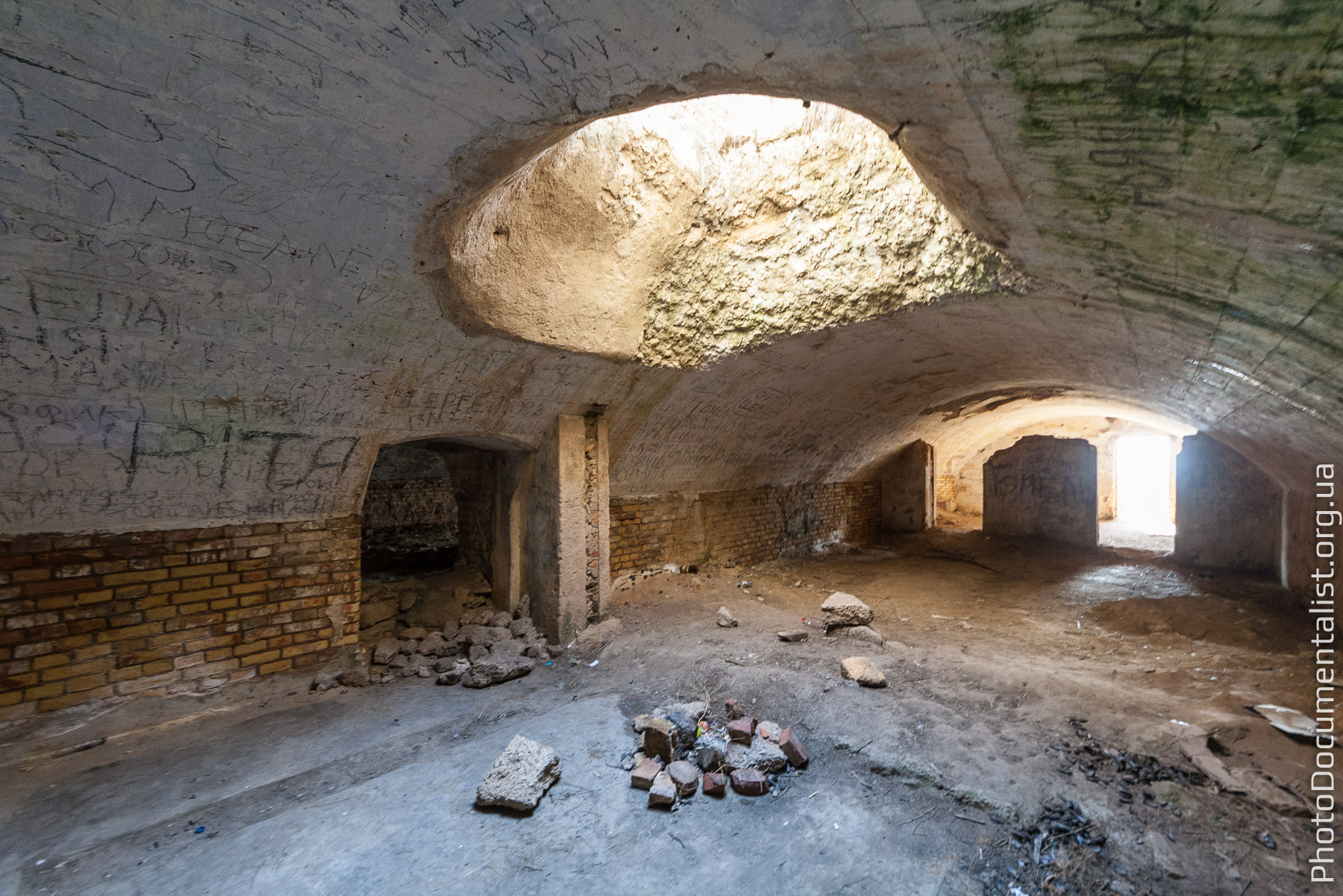


And Hermitage archaelogical tradition is very strong there. After Greeks who stayed there not for long (but left a LOT to be dug!) as there was no drinking water, it was used by most of the peoples who lived around (slavs, turks) as a transhipment/transfer point.
In 19th century is was fortified and then in 1910s used for some military tryouts. And fortified again in the 1930s, so some of the constructions from 1910s and 1930s are still there, some even adapted for the expedition needs!
There is also a story about lieutenant Schmidt who was executed on Berezan in 1906 for joining the fleet uprising. He is a vague, utterly mythologized figure. I once read a book composed of his real love letters written to a woman he once met (she came to see him before he was executed and then published the letters) – very touching! And since 1968 there is a monument to Schmidt on Berezan:
Hi Liza,
I am a bit too close to the bucket to keep bucket lists, but if I had one, Berezan would be on it. Wonderful stories, thank you! We wish you all at P-10 a happy Easter. M&M
Thank you, you too! In Russia we’ll have our ortodox Easter in a week, and this weekend me and my mom planned to be in Helsinki navigating museums as it kinda became a sponateous tradition for us through the past years to visit Helsinki on catholic Easter. Hope travels will come back to our reality soon!